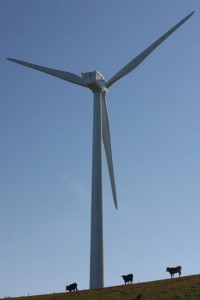Man always has been using wind energy. Cave ventilation or grain aeration for glumes removal all these are examples of the wind usage. For any savage crossing a lake was yet another experience of wind being helpful or hindering. So it is clear why boats have been rigged with sails since the beginning of time. Then came the turn of “land-based windjammers” – wind turbines.
Wind turbines are rather ancient device as they had been used for water elevating, sawing up logs, grinding flour – that is, in modern terms, to obtain mechanical energy. Owing to wind turbines the civilization received an evolution impulse. Then the decline came on. Windjammers don’t range the seas and oceans and wind turbines hardly can find its place in the energetics. Why did it happen?
There are definitely more powerful and handy energy sources. The demands for the quality of energy have definitely been stepped up as the lack of voltage or even voltage drops irritate consumers.
But material and device technology is not at a stop! Nowadays it should come as no surprise that there are composites and energy converters. Automatic machines and robots are doing hard and dangerous work for humans.
 So why modern wind turbines are so expensive?
So why modern wind turbines are so expensive?
Why an owner of a Jeep that has a few hundreds of HPs under the hood can’t afford having a wind turbine and his grandfather could build a windmill to grind flour for the whole community. Windmills had been standing at almost every village for tens or even hundreds of years. There are lots of reasons for that but I think the main ones are wrongly interpreted or being hushed up.
The modern energetics inclines to big stuff. The most powerful reactor or the most powerful turbine is a matter of the country’s international image! There is the same approach for wind turbines: the biggest wind turbine or the most powerful wind power generator is the pride and envy. One of the indicators of wealth and success of a country is quantity of energy per capita – the more, the better!
On the other hand centralized networks are just another way to control population or even the whole world. A law abiding citizen consumes energy working to pay the energy bills and keep his head down. If something goes wrong, the master switch goes down! Nowadays the one who has energy, rules the world.
But it’s not the case with the environmentally safe, alternative, green energetics. On one hand the energy is everywhere – sun, wind, waves are all around us. On the other hand the thickness is not that high and to harvest it energy receivers of large area are needed. Two approaches are possible here. A “sky-high” generator could be constructed which is oversized and very expensive (that’s the common thing with them) or to make hundreds of little ones scattered over a vast territory literally in every backyard.
But only the oversized giant fits into the total control centralized system and the hundreds of little ones could cause losing of the control and in the long run, the loss of the power itself. Sure enough no one is willing to give up on power! This is the reason for the evident and concealed opposition to the “small energetics”. No one has a stake in research and development of compact moderate-priced devices. Some models are developed and produced by efforts of few enthusiasts. But these models usually are copycats of the commercial giants just on a considerable scale.
There is the following issue behind it – integrity of the design characteristics. Actually design calculations recently become more available and the necessity of experimental verification was pushed to the sideliners. If you look through any of the online forums focused on engineering, you may notice that a great deal of trained (and not) users lock horns with each other on theoretical topics and no one sets about having a field test made. Those who actually make it to the metal are being watchful of as well as their practical results. The rule of good theory being tested by practice is somehow forgotten. As a result clueless schemes emerge just to discredit smart ideas.
If you put the abovementioned in wind energetics terms, you could see that the vast dry land territories are not perspective for setting up wind turbines as the wind intensity is insufficient. I beg you pardon! If this approach had been used by shipping companies, no one would have designed off-roaders as the railway is more advantageous for shipping the goods. But there is an approach for every task. If the wind was not sufficient for flour grinding, our ancestors used to spread sails between the blades and carried on. But modern “connoisseurs” can’t stand a wind sail turbine just because it doesn’t look too much of a propeller and they go on with shooting the bull! The airplane propeller theory is really well developed but why to apply it to an almost static mechanism? For different areas with different wind intensity different designs of wind turbines should be applied! A Formula 1 car cannot do the same thing a heavy-duty dump truck does!
Thus, the task of building a good wind turbine is transformed into a task to build the right kind of a wind turbine for a certain place and a certain consumer. Here it would be useful to do a research of the existing market and to define the goods and the bads of the designs available.
To be continued in “Perfect wind turbine criteria”…
Vadim Belyaev, “Vetronet”,
Design Manager

